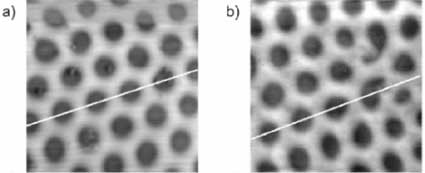
Home
Goals
Partners
Publications
Results
Gallery
Open position
Contact
Internal
Workshop 2006
The boron nitride nanomesh forms so far only on rhodium (Rh) and ruthenium (Ru)
It is experimentally observed that boron nitride nanomesh only forms on
rhodium (Rh)
and
ruthenium (Ru).
On these surfaces the nanomeshes are very similar, as it can be seen in the following two STM images.
The left image (a) represents a nanomesh formed on Rh(111)
, whereas the right one (b) corresponds
to a nanomesh on Ru(0001)
.  STM images of nanomesh on rhodium (left) and ruthenium (right).
The distance from the
center of a pore to the next one is of 3.2 nm.
Theoretical calculations showed that the differences in occupation degrees of bonding and
antibonding
states can explain the non-formation of nanomesh on other
transition metals
like
nickel or
platinum.
Nanomeshes formed on Rh and Ru are very similar, but some differences occur nevertheless. From these images it is for example visible that defects occur more often on Ru than on Rh, what leads to deviations from the mesh periodicity. This may be explained by a stronger interaction between the nanomesh and Ru in comparison to Rh. The boron nitride nanomesh forms on single crystals and crystal films
The cost of
single crystals
is very high since the crystal has to be impurity
free and cutted as wanted. In addition the price of Rh has tremendously increased
since 2002. In june 2007 it reached over 6'430 $/oz. h-BN nanomesh can be prepared on Rh(111) single crystals but also on single-crystalline Rh films with a typical thickness of 80-100 nm grown on Al2O3(0001). Nanomeshes prepared on both substrate s are similar. The details of Rh film preparation will be published later. References:
Angew.Chem.07 and
Surf.Sci.06
|
© 2007 University of Zurich
|
Webmaster
|
| Last update: 25.03.2008 by C. Galli Marxer
|